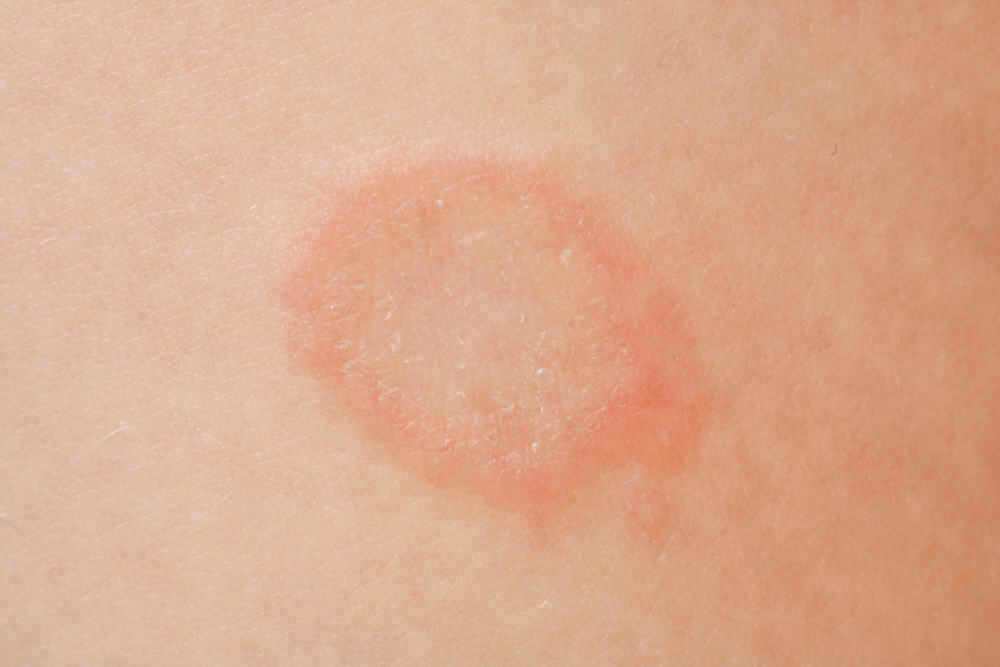Medically reviewed by Daniel Gutierrez, PA-C
A red, itchy rash isn’t just uncomfortable—in some cases, it’s mystifying. For instance, ringworm is one possible cause, but what does ringworm look like? Does it always cause a red circle rash? How can you tell this fungal skin infection apart from common skin rashes, including rashes that look like ringworm but aren’t?
Read on to learn about ringworm symptoms and how the rash is treated.
What are the symptoms of ringworm?
The symptoms evolve during different stages of ringworm. In early-stage ringworm, you’ll see a round, flat, irritated patch of skin. It may be reddish in people with light skin and brown-gray in people with darker skin. Sometimes the patch may simply be very dry or scaly. It typically shows up four to 14 days after you come in contact with the ringworm fungus and can appear on almost any area of the skin.
The patch enlarges during the second stage of the infection. This is when you’ll see the telltale red circle rash. The skin at the center of the patch may look relatively normal, but the skin surrounding it is raised, discolored and scaly.
You may notice other symptoms depending on what body part is affected.
Ringworm on the scalp (tinea capitis): Itchy dry and scaly patches, inflamed red patches, bald spots.
Ringworm on the face and neck (tinea barbae): May be crusted over or contain pus.
Ringworm on the rectum, groin or inner thighs (tinea cruris or “jock itch”): Itching and, in some cases, blisters.
Ringworm on the hands (tinea manuum): Dry, cracked palms.
Ringworm on fingernails and toenails (onychomycosis and tinea unguium): Thick, discolored and deformed nails.
Ringworm on feet (tinea pedis or athlete’s foot): Starts between the toes and causes stinging, burning, blistering and peeling skin.
Rashes that look like ringworm but aren’t
If you’re not sure if your rash is ringworm, it’s important to see your dermatologist to rule out other skin conditions that cause similar symptoms. These include:
How do you get ringworm?
The ringworm fungus commonly lives on the surface of the skin. If exposed to warm, humid, dark conditions, it can multiply and turn into an infection.
A ringworm infection spreads easily from person to person via skin-to-skin contact and by sharing clothing, bedding or towels with someone who’s infected. Touching ringworm fungus lurking in showers or locker rooms can infect you.
You can get ringworm from a dog or cat if it has ringworm. Rarely, ringworm can be spread through prolonged contact with soil that contains the fungus.
Factors that make you more vulnerable to ringworm include playing high-contact sports, sweating excessively and working with animals who may have the infection. You’re also more likely to get ringworm if you have nail or skin injuries, diabetes, obesity or a compromised immune system.
Does ringworm go away on its own?
It’s unlikely the rash will vanish without treatment, so don’t ignore it. A mild case of ringworm might go away on its own if you scrupulously follow self-care measures, such as keeping the area clean and dry, but you might spread it to other body parts while you wait for it to heal.
How to treat ringworm
Ringworm can typically be treated by applying an over-the-counter topical antifungal product such as terbinafine (Lamisil) or clotrimazole (Lotrimin) for two to four weeks. See your dermatologist if you don’t see improvement or the rash has gotten worse. More serious ringworm infections may need a prescription antifungal and can take up to two months to heal.
If treatment doesn’t work, it could mean that the fungus is resistant to the antifungal medicine you used, whether it was over-the-counter or prescription. If that’s the case, you may need a stronger or newer antifungal cream.
The toughest ringworm cases may require an oral antifungal medicine. The doctor will perform a biopsy first to confirm that you have a fungal infection.
Ringworm on the scalp won’t go away on its own and requires treatment with oral medication.
During treatment, take steps to prevent the ringworm rash from spreading. Even after the rash is gone, reduce your chance of getting infected again with these tips:
Keep your skin clean and dry.
Don’t walk barefoot in public showers and locker rooms.
Change your underwear and socks at least once a day.
Don’t share clothing, linens or personal items.
Clip your nails short and keep them clean.
If you play a high-contact sport, shower immediately afterward and wash/clean your clothing and sports gear.
Use disinfectant sprays or bleach to clean surfaces that might harbor the ringworm fungus, such as the shower, doorknobs and bathroom countertops.
Take your pet to the vet if it has signs of ringworm.
Ringworm stages of healing
Ringworm can take at least two weeks to heal. The rash will gradually fade and the skin will become smooth. If you stop using the antifungal treatment before the rash is gone, the infection might return and be harder to treat, so be sure to follow the treatment instructions.
If the rash is warm to the touch, contains pus or leaks fluid, it’s likely infected. See your doctor right away.
Once the rash is gone, you may have post-inflammatory skin discoloration that remains for months. The skin could be lighter, darker or redder than the surrounding skin. Through the natural process of exfoliation, it will eventually return to its normal color.
Ringworm pictures
See the photos below for examples of what ringworm looks like. Keep in mind that ringworm looks different at different stages, on different parts of the body and in different people.
Written by Jessica Brown, a health and science writer/editor based in Nanuet, New York. She has written for Prevention magazine, jnj.com, BCRF.org, and many other outlets.
